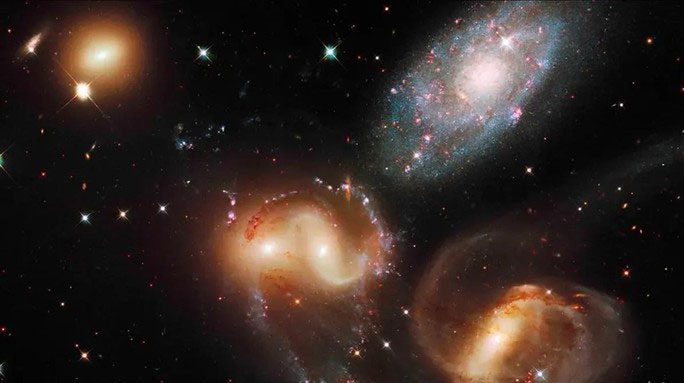Not only does it disguise itself as a shining star in the sky, but a mysterious black hole also “blinds” people on Earth. However, what the black hole conceals has emitted a special signal.
Using a complex technique and NASA’s Hubble Space Telescope, a multinational team of astronomers has successfully “rescued” an 11 billion-year-old galaxy from a quasar located in the Stephan’s Quintet galaxy group.
Instead of observing the light emitted by what scientists refer to as the “ancient kingdom”, they focused on the light it absorbs.

The Stephan’s Quintet galaxy group also hosts another hidden galaxy, closer to Earth than its companions – (Photo: NASA/ESA/Hubble SM4 ERO Team).
This galaxy is not very far from Earth and is easily observable by Hubble. However, everything was obstructed by a quasar. The quasar is a black hole, but by consuming material voraciously, the energy emitted from what it devours creates a bright region akin to a star.
Thus, from Earth’s perspective, it appears as a star, but in reality, it is not.
According to Live Science, the dazzling brightness of this supermassive black hole has caused the ancient galaxy scientists are searching for to be “swallowed.” Similar to how an overly bright headlight makes it difficult to see anything alongside, behind, and even in front of it.
However, the galaxy is still able to send signals to Earth by turning the quasar red. Of course, this is not a signal from a civilization but from a natural process: Starlight from the galaxy has absorbed blue light from the quasar, leaving behind red light.
Therefore, through an “upside-down” observation, scientists were able to find it.
According to Dr. Lise Christensen, a member of the research team from the Niels Bohr Institute (NBI – Denmark), the characteristics they observed in the “ancient kingdom” show many similarities with the galaxy containing Earth, the Milky Way.
This ancient galaxy seemingly has a “twin,” closer, smaller, yet brighter. The second galaxy appears to be forming stars at an incredibly rapid rate, so close to the main galaxy that they may be a bound pair due to gravitational attraction.
These two galaxies could serve as a miniature model of the galaxy group that includes the Milky Way, a “monster” galaxy that interacts gravitationally with its satellite galaxies.
Most importantly, identifying a world that is 11 billion years old is incredibly valuable, as it allows scientists to look back at the dawn of the universe. Our universe is about 13.8 billion years old, meaning this “kingdom” emerged less than 3 billion years after the Big Bang.


















































